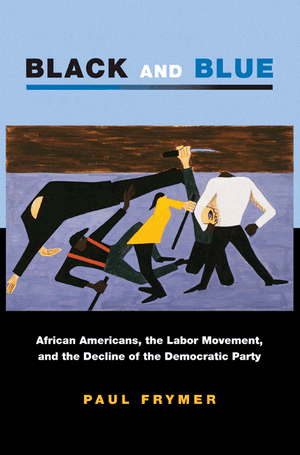 book, Deardorff writes, Frymer "attempts to integrate the schools of New Institutionalism and American Political Development, as well as the theory of intersectionality, within his research."
book, Deardorff writes, Frymer "attempts to integrate the schools of New Institutionalism and American Political Development, as well as the theory of intersectionality, within his research." While some excellent research has been conducted exploring the history of African Americans in the labor movement and during the New Deal (Kelley 1990; Sullivan 1996), within political science this has resulted in the following historical narrative: legislative change, followed by a strategy of litigation, resulting in union desegregation. Frymer makes a compelling case that when we deliberately set about to integrate race and class within the civil rights and labor narratives, we find that they are not sequential, but intertwined. He asserts that the institutions created to help democratize class – the Wagner Act of 1935 and the National Labor Relations Board (NLRB) – and race – Title VII of the Civil Rights Act of 1964, Equal Employment Opportunity Commission (EEOC), and the Federal Employment Practice Committee (FEPC) – did not work coherently to prevent racial discrimination in unions while simultaneously advancing the workers’ power. Instead they were striving at cross-purposes and cross-agendas. As a consequence, the role of the federal courts in enforcing civil rights legislation is much larger and significant than previously understood; its result, according to Frymer, was the gutting of the labor movement and the subsequent decline of the Democratic party. This is an intriguing argument and one that substantially bolsters the contention that racism in America is institutional, [*193] despite the continued emphasis on personal attitudes. In the introductory chapter, Frymer seems to imply these choices were the result of arrogance and poor judgment on the part of civil rights organizations and the judiciary. As his narrative unfolds, however, it becomes evident that he believes that the legislation establishing these institutions, the internal cultures of the NLRB and EEOC, as well as the subsequent choices made by Congress, rendered a strong judicial role inevitable.
At the end of the book,
Frymer turns to the questions of how this alternative interpretation of the empowerment of post-New Deal federal courts should influence judicial scholarship. Most importantly, he challenges – in a different fashion than the usual rejoinder – Alexander Bickel’s “countermajoritarian” critique. While he traces the recently revised perspective of many progressive legal scholars as to the appropriate role of the courts in policy making, Frymer argues that an institutional perspective recognizes that both the legislature and the courts inevitably have policy-making functions in a democratic society. BLACK AND BLUE is a powerful demonstration of how a different theoretical paradigm can result in new interpretations of not only historical events, but current understandings of both racism and judicial legitimacy.
Read the rest here.